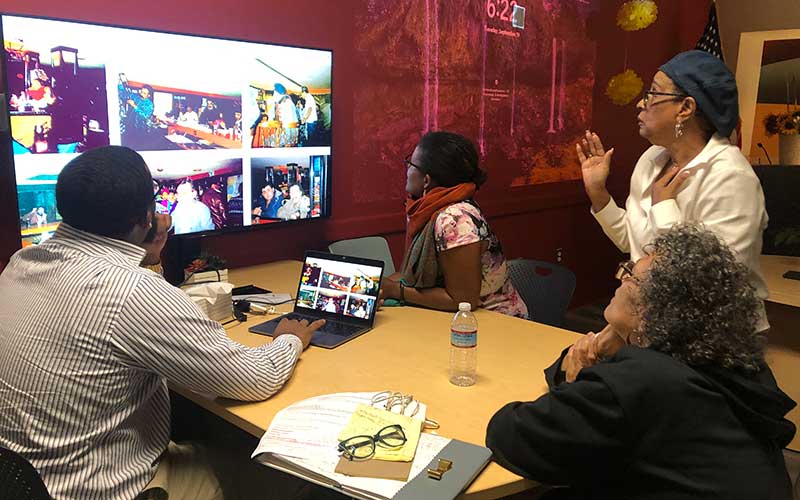
New Bedford resident researchers review submissions for their photo book project. Photo: Shinelle Kirk
For neighborhoods fragmented by gentrification, it can be hard to hold onto vital cultural history. Case in point: When Karen Jenkins purchased a home in New Bedford, Massachusetts, she didn’t recognize it until she entered the building. Only then did she realize she was buying the site of the basement bar that had once formed the center of her and much of her Cape Verdean community’s social life.
The “Bomb Shelter,” as the bar was known, may have been unconventionally placed in the cellar of a residential multifamily building. Still, it was a beloved landmark for the Cape Verdeans of New Bedford and the surrounding area. Founded in the 1930s by Alfred Pina, a local Cape Verdean society leader, the Bomb Shelter served as a vital cultural hub for five decades. The space began as a political club and evolved into a bar and social center.
Jenkins spoke for many Cape Verdeans when she wrote in a photo book about the Bomb Shelter that the bar “has become the embodiment of my connection to my heritage and my identity.” The New Bedford Cape Verdean community recently granted the old club recognition and fresh life with the support of local partners involved in CLF’s Healthy Neighborhood Study program.
Strengthening social ties in the face of gentrification
In May 2023, the Bomb Shelter was reborn for a day. Its restoration was part of a multi-year initiative CLF has undertaken with MIT and 45 resident researchers from nine Massachusetts communities, with funding from the Robert Wood Johnson Foundation. The Healthy Neighborhoods Study’s objective is to understand how to build neighborhoods in ways that improve the health of residents. For the resident researchers – including Karen Jenkins – who designed and conducted the study, the findings are deeply personal. They reveal trends about their hometowns and the ways that issues like gentrification and displacement affect their neighbors.
One of the study’s most powerful takeaways is the role of community culture and history in promoting health. As rising rents and cost of living have priced many Cape Verdeans out of New Bedford, much of their local history has been lost.
Bringing the Bomb Shelter back to life honored the neighborhood’s history while strengthening connections to residents’ shared culture. The study also found that social ties are critical to good health, so recognizing a vital piece of the Cape Verdean social fabric empowered the community.
“[The Bomb] provided the social support that we talk about in the Healthy Neighborhood Study as a determinant of health,” notes resident researcher and site coordinator Gail Roderigues.
Creating a historical record
The local Cape Verdean community responded enthusiastically to requests from the local Healthy Neighborhoods Study team for photos and information about the Bomb Shelter. That team included Jenkins and Roderigues as well as resident researchers Dina Abreu and Jacqueline Pina and CLF research associate Shinelle Kirk. The team received treasured snapshots highlighting a beloved longtime bartender, cheerful live music, a crowded dance floor, and much joyful socializing. They compiled the snapshots into a book that also shared information about the club, quotes from people involved in its founding and running, and perspectives on Cape Verdean history.
After publishing the book, the team ensured copies were widely available. The local library even accepted one. The team also shared the book online for anyone to read. Pina, who grew up across the street from the Bomb Shelter and frequented it as an adult, says the project signifies joy for her. “That’s what that book means to me, and that’s why I would love for people to get this book.”
Reviving the Bomb Shelter
As soon as Karen Jenkins moved into her new house, neighbors began asking when she would reopen the bar – a testament to the long-lasting legacy of the gathering spot. Unfortunately, renovations to the basement meant it could no longer function as a commercial club. However, at Jenkins’ suggestion, the Healthy Neighborhoods Study team decided opening the space for a temporary revival would provide a powerful way to honor its role in the community. Last May, “The Bomb” lived for just a few more hours.
Jenkins and the team widely advertised the one-day event within and beyond the Cape Verdean community. They hoped for at least 10 attendees. In the end, 60 showed up. A welcoming message in both English and Cape Verdean Creole greeted all visitors at the Bomb Shelter door, promising them that, “Together, we can build a future that honors our past and creates new memories and experiences for generations to come.” Attendees perused copies of the photo book and snacked on tasty Cape Verdean food. Cape Verdean live music once again rang through the basement.
People reminisced about the meaningful role the club played in their lives. A Healthy Neighborhood Study resident researcher took oral histories from several attendees. Some people even reconnected after years of not seeing one another. One person said it felt like a family reunion.
A stronger community for a stronger future
The event both demonstrated and revitalized the love and loyalty of the New Bedford Cape Verdean community. Their culture and camaraderie kept the Bomb Shelter alive for almost half a century. That same dedication shone throughout this project. As the residents of this neighborhood face increasing threats from gentrification, this powerful social fabric will prove vital in sustaining them. As the last page of the Bomb Shelter photo book reads, “This is my home. I’m not going anywhere.”



